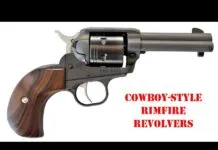The trend for making smaller and smaller pistols continues, with new guns by major makers coming out every few months, it seems. We just tested the supposedly small, but actually midsize by modern standards, new Ruger LC9 against the established Kel-Tec PF-9, with the latter coming out the winner. Many 9mm handguns now come a lot smaller than that, with the Kahr PM9 and the Rohrbaugh being among the smallest. Yet the Kel-Tec PF-9 was thinner and lighter than the small Kahr, while still being large enough to grasp and shoot easily, if somewhat attention-getting on recoil.
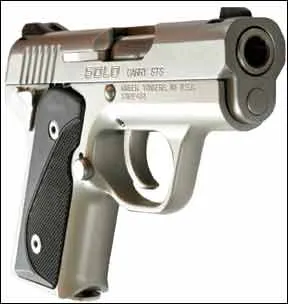
Now Kahr has come out with a lower-priced version of the PM9 called the CM9, and we’ll have one of those in hand shortly. Meantime, Kimber has announced its Solo Carry, which is in the tiny-nine world by virtue of its size. We acquired one of the Kimber Solo pistols ($747 MSRP) , and in our eagerness to test it, put it up against another nine we’ve never tested, Kahr’s CW9 ($549 MSRP). The big question we had was, Just how small can a gun become yet still be manageable when loaded with serious ammunition? In the course of our testing another question arose, and that concerns how strong the shooter has to be to manipulate the small guns with stout-enough springs to control hot loads.
We tested them with four types of ammunition: Black Hills 147-grain FMC, Winchester 115-grain BEB, Remington 115-grain JHP, and Federal 124-grain Hydra-Shok JHP. Here is what we found.
Kimber Solo Carry STS
9mm Parabellum, $747
There are two versions of the Solo, one having an all-matte-silver finish, which is what we tested, and one with a two-tone setup, black frame and matte-stainless slide, with the same price on both guns. They both have aluminum-alloy frames and stainless-steel
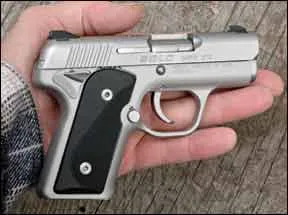
slides. The Solo takes +P ammo, holds six in the magazine, and has an ambidextrous safety and magazine release. Two mags came with the gun. The stainless barrel is short, 2.7 inches. With the slide locked back, the barrel is free to shake about in an alarming manner.
The grip panels are removable, and we thought the gun was highly attractive. One trick used by Kimber was to try to emulate the look and feel of a 1911 auto, so the hand accustomed to the big pistol feels right at home on the Solo. The Solo’s controls were in much the same positions as those on the big gun, but this is no 1911. The rear of the gun is smooth, which we found was kind to the shooting hand, for the most part. The front strap was also smooth. We’d like to see some fine checkering or other traction device there, because the gun had a tendency to twist in the hand on recoil.
The sights were flat black and made of steel. They were smooth to help prevent snagging on clothing and to ease holstering. They
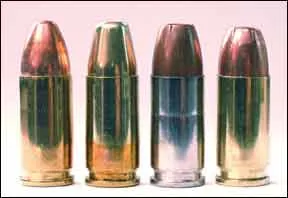
had three white dots, were well-proportioned, and gave an excellent sight picture. Both were dovetailed into the slide, the rear being secured by an Allen screw and drift-adjustable for windage. The smooth-button, ambidextrous magazine releases were essentially spring-loaded to the center. Pressing either button permitted the magazine to come out. However, the heel of our normal hand, grasping the gun normally, would not permit the magazine to drop freely. The mag well was beveled for easier reloading.
The ambidextrous safety levers were very well done, we thought. They indeed moved like those on a 1911 pistol, but did not interfere with the fingers in any way. The safety levers, though small, were easy to put on or take off with the hand in the shooting position. They were positive, with no slop in their motion. Kudos to Kimber for them. The overall fit and finish of the gun were excellent. The finish (Kimber calls it KimPro II) was one of the nicest we’ve seen on any handgun. The six-round magazines (eight-round optional) were also nicely finished, bright and shiny.
Kimber thinks the trigger sets a new standard for small pistols. We tend to agree. This gun’s trigger pull was one of its more attractive
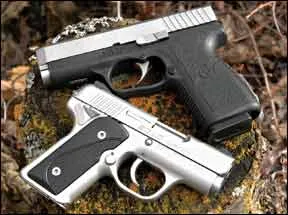
points to our test crew. But we had some complaints. Before we took the gun to the range we noted it was extremely difficult to lock the slide back. It took lots of muscle to haul the slide back against its recoil spring until the slide stop clicked up into place. That alone will keep a whole lot of people from buying this handgun, we believe. We found a reluctance for the lever to spring upward on its own even when we managed to haul the slide back all the way with an empty magazine in place. Further, Kimber’s instruction manual recommends that the recoil spring be replaced after 1000 rounds.
Takedown was incredibly easy, and familiar to those who know the 1911. Clear the gun, and move the slide back until a small notch in the left side of the slide lines up with the rear of the cross pin, and slip the cross pin out. Let the slide go forward, press the trigger (after again making sure the chamber is empty) and ease the slide forward off the receiver. Remove the compound slide spring, rotate the barrel to the side 45 degrees, and out it comes. Be prepared for a surprise when you first open up the Solo. It’s absolutely beautiful inside, with complex parts all very well made. The machining on the interior of this tiny gat is better than that on the outside of many guns. Reassembly was easy, but the recoil
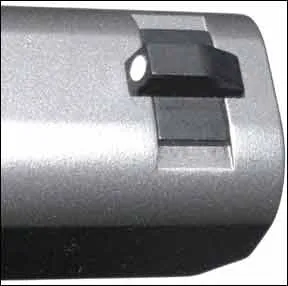
spring was still a bear.
On the range we loaded the gun first with some heavy loads and tried a few shots one handed. With 147-grain FMJ Black Hills ammo there was no pain. The gun just shoved our hand upward. But we noticed a sharp rap on our third finger from the sharp front edge of the magazine. In extended shooting for accuracy, this sharp edge cut through the skin of our third finger. We don’t like it when a gun makes us bleed. The solution would be to soften that sharp edge. However, we also had a very hard time getting the magazine out when we had the first of two jams. There’s not enough magazine to grab. Maybe the eight-round magazine would be easier to get out, but we did not have one to test. If the lip were extended forward another eighth of an inch it would provide more of a ledge to pull on. That may or may not help the gouging of the third finger.
We had two failures to feed from that 147-grain FMC ammo during our accuracy testing. It happened when the gun was being held very firmly with both hands. Although the empties got out of the gun both times, the next round failed to go home. The solution was to shove the slide forward. We wondered if the vague position of the barrel when the slide was fully back was a factor there, but the system did seem to work okay most of the time. After our accuracy testing we disassembled the gun, and may have found
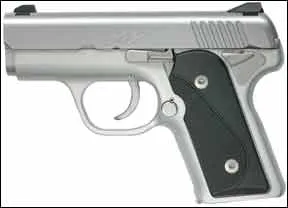
the source of the failures to feed. The gun was bone dry, no lubrication at all that we could see. Even without lube, the failures to feed happened relatively early in our test shooting and did not recur, perhaps attesting to Kimber’s claim of its finish being self-lubricating.
We thought the accuracy of the Solo was adequate, if not stellar. Elevation was on the money at 15 yards. If we owned the gun we’d drift the rear sight to print 2 inches farther left at that range and call it good. We found the trigger of the Solo to be excellent for rapid-fire shooting, but we thought the addition of some sort of stickiness to the front and perhaps rear grip straps would help prevent the gun’s tendency to twist off line from the relatively hefty recoil.
Our Team Said: All in all, we liked the Solo, but we wonder about the extraordinary force needed to chamber a round or lock the slide back. As noted, we think Kimber needs to bevel or round the front edges of the magazines to prevent cutting the fingers.
Kahr CW9 9mm Parabellum, $549
The two-tone Kahr was much more user friendly to our shooters’ hands. Easy to grasp and kind with recoil, the Kahr was a relief after the Solo. The polymer frame had stepped serrations on both straps that helped us keep a good grip on the gun, and did a lot to prevent twisting in recoil. We could get all fingers of our shooting
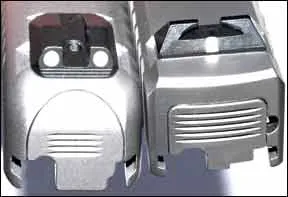
hand on the grip, which was another relief for our beleaguered hands. No, this gun is not as small as the Solo, but we believe some shooters are going to think the Solo is too small. The Kahr was about an inch longer and just over half an inch higher. The widths were the same, but the Kahr weighed 1.3 ounces more, 18.6 compared to 17.3. The previously tested Kel-Tec beat them both badly for weight at 14.8 ounces empty.
The slide was matte-finish stainless, and the one-piece frame was polymer with steel inserts at the wear points. The sights were plastic on this one, but we had no trouble with them in our testing. The sight picture was excellent, about equal to the Solo’s. There was one white dot on each sight. We’d have preferred two white dots in back. The rear sight was driftable for windage, but there was no locking screw. The elevation was about on the money at 15 yards with all the test ammo. The ejection port had some sharp edges that didn’t belong. So did the magazine well edges, and all of these could be easily removed with a knife, file, or sandpaper. The magazine held seven rounds, and only one magazine came with the gun.
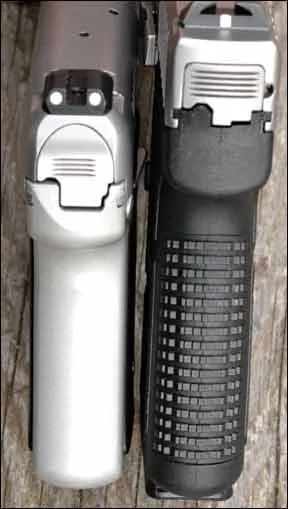
Disassembly was almost as easy as for the Solo, with the exception that you had to hold the slide with two marks lined up on the left side, and then rap the cross pin on the right side. Why don’t they put the marks on the right side? Inside, we found clean work, with no surprises. We could see where Kimber got its idea to secure the firing pin. Reassembly was simple. Both test guns had a little spring that had to be put in the right place during reassembly of the cross pin.
On the range our first impression was that the trigger would never break. We had just fired the Solo with its excellent trigger, and switching frequently between the two invariably gave us the impression the Kahr’s trigger pull was too long. But this trigger has served Kahr a long time, so what this means is you have to get used to the gun in your hands to do good work with it. Accuracy was on a par with the Solo, not exceptionally good nor bad, but entirely adequate for such a gun, we thought. The Kahr was much more comfortable to shoot than the Solo and it didn’t cut our hands. There were no problems with the gun at all.
During rapid fire the Kahr was much slower for the first shot than the Solo but maybe a little faster for the second, and it was much easier to put the second fast shot on target. Practically speaking, the Solo could be made to shoot faster because of its superb trigger, and the first shot might be the only one you get. But we had a harder time keeping the follow-up shots where we wanted them because of the Solo’s tendency to twist in our hands. The shots from the Kahr all landed where we wanted them. Happily neither gun had a magazine disconnect. We don’t believe they belong on a self-defense handgun.
Our Team Said: We think more shooters will be comfortable
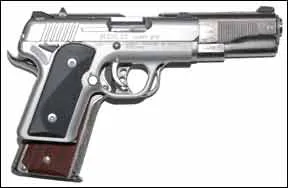
with the Kahr than the Solo. Although it’s larger and perhaps not in the same exact category, the Kahr is easier to shoot, easier on the hand and pocketbook, and seems to be reliable. We are starting to think some guns are just too small, but we haven’t tried them all yet. A bit of roughness that we felt in the Kahr’s slide movement was somewhat abated by the end of our shooting. We suspect the Kahr will find lots of buyers, especially among those who lack the strength to force the Solo’s slide back by hand.
0511-SMALL-9MM-ACCURACY-AND-CHRONO.pdf
0511-KIMBER-SOLO-CARRY-STS.pdf




